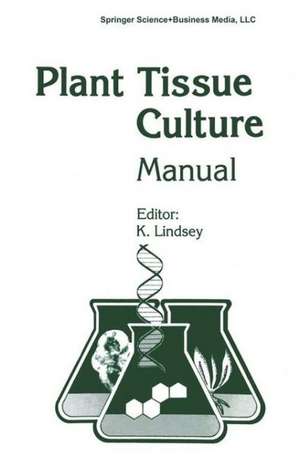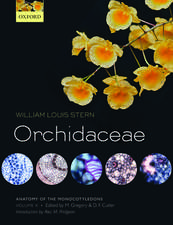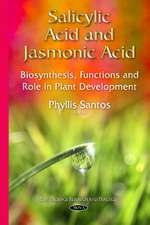Plant Tissue Culture Manual - Supplement 7: Fundamentals and Applications
Editat de K. Lindseyen Limba Engleză Paperback – 23 aug 2014
Preț: 468.24 lei
Nou
Puncte Express: 702
Preț estimativ în valută:
89.61€ • 92.57$ • 74.58£
89.61€ • 92.57$ • 74.58£
Carte tipărită la comandă
Livrare economică 21-27 martie
Preluare comenzi: 021 569.72.76
Specificații
ISBN-13: 9789401176583
ISBN-10: 9401176582
Pagini: 1228
Ilustrații: XXXII, 1187 p. In 2 volumes, not available separately.
Dimensiuni: 155 x 235 x 64 mm
Ediția:1997
Editura: SPRINGER NETHERLANDS
Colecția Springer
Locul publicării:Dordrecht, Netherlands
ISBN-10: 9401176582
Pagini: 1228
Ilustrații: XXXII, 1187 p. In 2 volumes, not available separately.
Dimensiuni: 155 x 235 x 64 mm
Ediția:1997
Editura: SPRINGER NETHERLANDS
Colecția Springer
Locul publicării:Dordrecht, Netherlands
Public țintă
ResearchCuprins
1. Media preparation.- 2. The initiation and maintenance of callus cultures of carrot & tobacco.- 3. The initiation and maintenance of plant cell suspension cultures.- 4. Shoot cultures and root cultures of tobacco.- 5. Somatic embryogenesis in orchardgrass.- 6. Arabidopsis regeneration and transformation (leaf & cotyledon explant system).- 7. Arabidopsis protoplast transformation and regeneration.- 8. Arabidopsis regeneration and transformation (root explant system).- 9. Somatic embryogenesis in carrot.- 10. Low density cultures: microdroplets and single-cell nurse cultures.- 11. Tobacco protoplast isolation, culture and regeneration.- 1. Embryogenic callus, cell suspension and protoplast cultures of cereals.- 2. Transformation and regeneration of rice protoplasts.- 3. Transformation and regeneration of orchardgrass protoplasts.- 4. Transformation and regeneration of oilseed rape protoplasts.- 5. Regeneration and transformation of potato by Agrobacterium tumefaciens.- 6. Transformation of tomato with Agrobacterium tumefaciens.- 7. Regeneration and transformation of sugarbeet by Agrobacterium tumefaciens.- 8. Regeneration and transformation of apple (Malus pumila Mill.).- 9. Transformation and regeneration of maize protoplasts.- 10. Regeneration and transformation of barley protoplasts.- 11. Agrobacterium-mediated transformation of potato stem and tuber tissue, regeneration and PCR screening for transformation.- 12. Production of fertile transgenic wheat by microprojectile bombardment.- 13. Transient gene expression and stable genetic transformation into conifer tissues by microprojectile bombardment.- 1. Clonal propagation of orchids.- 2. Clonal propagation of palms.- 3. Clonal propagation of conifers.- 4. Cytological techniques.- 5. Restriction fragment analysis of somaclones.- 6. Virus elimination and testing.- 7. Clonal propagation of Citrus.- 8. Clonal propagation of eucalypts.- 9. Cryopreservation of plant tissue cultures: the example of embryogenic tissue cultures from conifers.- 1. Gene transfer by particle bombardment.- 2. Transformation of pollen by particle bombardment.- 3. Electrical fusion of protoplasts.- 4. Cybrid production and selection.- 5. Fluorescence-activated analysis and sorting of protoplasts and somatic hybrids.- 6. RFLP analysis of organellar genomes in somatic hybrids.- 7. Isolation and uptake of plant nuclei.- 8. In situ hybridization to plant metaphase chromosomes: Radioactive and non-radioactive detection of repetitive and low copy number genes.- 9. Chemical fusion of protoplasts.- 1. In vitro fertilisation of maize.- 2. Endosperm culture.- 3. Endosperm culture.- 4. Hybrid embryo rescue.- 5. In vitro culture of Brassica juncea zygotic proembryos.- 6. Production of haploids in Brassica spp. via microspore culture.- 1. Use of chemical and physical mutagens in vitro.- 2. In vitro culture, mutant selection, genetic analysis and transformation of Physcomitrella patens.- 1. Tropane alkaloid biosynthesis in vitro.- 2. Anthocyanin biosynthesis in vitro.- 3. Biosynthesis of monoterpene indole alkaloids in vitro.- 1. Establishment of photoautotrophic cell cultures.- 2. Zinnia mesophyll culture system to study xylogenesis.- 3. Cell cycle studies: induction of synchrony in suspension cultures of Catharanthus roseus cells.- 4. Thin Cell Layer (TCL) method to programme morphogenetic patterns.- 5. In vitro infection of Arabidopsis with nematodes.- 6. Asparagus cell cultures as a source of wound-inducible genes.- 7. Use of video cell tracking to identify embryogenic cultured cells.






